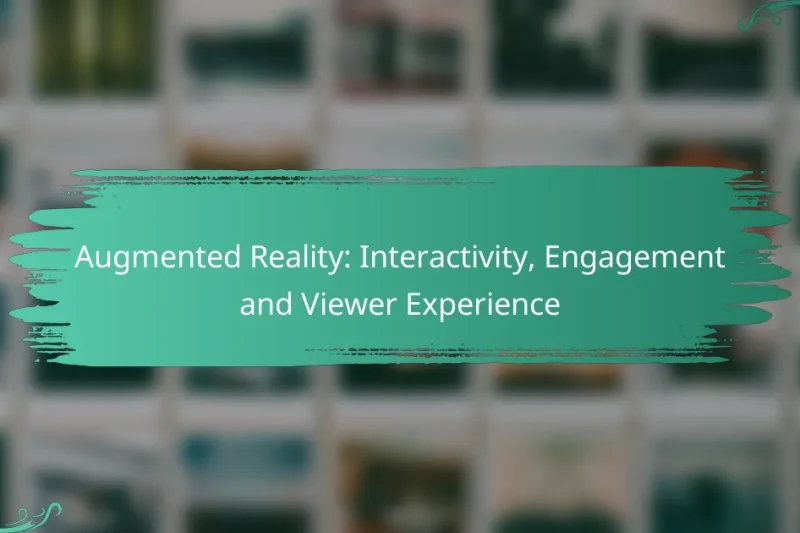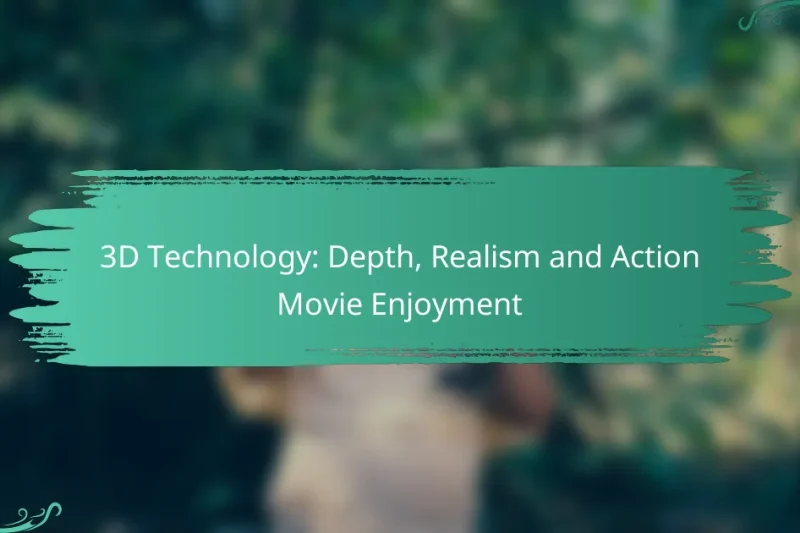Dolby Atmos revolutionizes sound quality by delivering an immersive audio experience that envelops listeners in a … Dolby Atmos: Sound Quality, Immersion and Audiophile SatisfactionRead more
Technology Enhancing Movie Experiences
Technology is revolutionizing the movie experience, particularly in Los Angeles, by incorporating immersive elements that captivate audiences. Innovations like virtual reality, advanced sound systems, and interactive storytelling are transforming how films are enjoyed, making them more engaging and memorable.
Augmented Reality: Interactivity, Engagement and Viewer Experience
Augmented Reality (AR) transforms viewer experiences by merging digital content with the physical world, fostering interactivity … Augmented Reality: Interactivity, Engagement and Viewer ExperienceRead more
3D Technology: Depth, Realism and Action Movie Enjoyment
3D technology has revolutionized the way action movies are experienced, offering viewers an unparalleled sense of … 3D Technology: Depth, Realism and Action Movie EnjoymentRead more
Home Theater Systems: Performance, Features and Movie Experience Optimization
Creating an immersive home theater experience requires careful consideration of performance and features that enhance both … Home Theater Systems: Performance, Features and Movie Experience OptimizationRead more
Virtual Reality: Immersion, Engagement and User Experience
Virtual reality (VR) revolutionizes user experience by offering immersive environments that engage and captivate users on … Virtual Reality: Immersion, Engagement and User ExperienceRead more
How is technology transforming movie experiences in Los Angeles?
Technology is significantly enhancing movie experiences in Los Angeles by introducing immersive elements that engage viewers more deeply. Innovations such as virtual reality, advanced sound systems, and interactive storytelling are reshaping how audiences enjoy films.
Virtual reality (VR) cinema
Virtual reality cinema allows viewers to step inside the movie world, offering a 360-degree experience that traditional screenings cannot match. In Los Angeles, venues are beginning to incorporate VR setups, where audiences wear headsets and can look around the environment as the story unfolds.
This technology creates a sense of presence, making viewers feel as if they are part of the action. However, it requires specialized equipment and can lead to motion sickness in some users, so it’s essential to ensure comfort and accessibility when implementing VR experiences.
Enhanced sound systems
Enhanced sound systems, such as Dolby Atmos, provide a multi-dimensional audio experience that immerses viewers in the film’s environment. These systems allow sound to move around the audience, creating a more realistic and engaging atmosphere.
Theaters in Los Angeles are increasingly adopting these advanced audio technologies, which can significantly elevate the overall viewing experience. When choosing a cinema, look for venues that advertise these sound enhancements to fully enjoy the film’s audio landscape.
Interactive storytelling
Interactive storytelling transforms the traditional linear narrative by allowing audiences to make choices that affect the plot’s direction. This approach is gaining traction in Los Angeles, with some filmmakers experimenting with apps or on-screen prompts that let viewers influence the story.
While this can create a unique and personalized experience, it also requires careful planning to ensure that the narrative remains coherent and engaging. Filmmakers should consider the balance between interactivity and storytelling to avoid overwhelming the audience with too many options.
What are the benefits of immersive cinema technology?
Immersive cinema technology enhances the movie experience by creating a more engaging and interactive environment for viewers. This technology utilizes advanced visual and audio systems to draw audiences deeper into the narrative, making films more captivating and memorable.
Increased audience engagement
Immersive cinema technology significantly boosts audience engagement by incorporating elements like 3D visuals, surround sound, and even sensory effects. These features create a more dynamic viewing experience, keeping the audience’s attention focused on the film.
For instance, IMAX theaters utilize larger screens and high-resolution imagery to envelop viewers, making them feel part of the action. This heightened engagement can lead to longer retention of the film’s themes and messages.
Enhanced emotional connection
By immersing viewers in a multi-sensory environment, cinema technology fosters a stronger emotional connection to the story and characters. Techniques such as spatial audio and realistic visuals help evoke feelings that resonate more deeply with the audience.
For example, a film that uses 4D effects, including motion seats and environmental elements like wind or mist, can amplify emotional responses during key scenes. This connection often results in a more impactful viewing experience, encouraging discussions and reflections long after the credits roll.
Which technologies are leading the way in cinema enhancement?
Several technologies are significantly enhancing the cinema experience, focusing on sound quality, visual clarity, and immersive interactions. Key players include Dolby Atmos for sound, IMAX for visuals, and augmented reality (AR) for interactive experiences.
Dolby Atmos sound technology
Dolby Atmos revolutionizes sound in cinemas by creating a three-dimensional audio environment. Unlike traditional surround sound, it allows sound to move freely around the audience, making them feel as if they are part of the action.
This technology uses overhead speakers and advanced sound processing to deliver a more immersive experience. Cinemas equipped with Dolby Atmos can enhance the emotional impact of films, making scenes more engaging and realistic.
IMAX projection systems
IMAX projection systems are designed to deliver superior image quality and larger-than-life visuals. These systems utilize high-resolution projectors and specially designed screens to provide a clearer, brighter picture with enhanced color accuracy.
IMAX theaters often feature a larger screen that extends to the edges of a viewer’s peripheral vision, creating a more immersive viewing experience. This technology is particularly effective for action-packed films and visually stunning animations.
Augmented reality (AR) experiences
Augmented reality (AR) experiences in cinema enhance storytelling by overlaying digital content onto the real world. This technology allows viewers to interact with characters and scenes through their devices, creating a unique blend of film and interactive gameplay.
AR can be used in promotional campaigns or as part of the film experience itself, offering viewers additional content or interactive elements that deepen their engagement. As AR technology continues to evolve, its integration into cinema is expected to grow, providing new ways for audiences to connect with films.
How do streaming platforms utilize technology for better movie experiences?
Streaming platforms enhance movie experiences by leveraging advanced technologies like algorithms for content delivery, high-definition video formats, and user interface improvements. These innovations aim to provide viewers with seamless access to a wide range of films while ensuring high-quality playback and personalized viewing options.
Personalized recommendations
Personalized recommendations are a key feature of streaming platforms, utilizing algorithms that analyze user behavior, preferences, and viewing history. By tracking what users watch and how they rate content, these systems suggest movies that align with individual tastes, making it easier to discover new favorites.
For example, platforms like Netflix and Amazon Prime Video often display tailored suggestions on the homepage, which can significantly enhance user engagement. Users should regularly update their viewing preferences and ratings to improve the accuracy of these recommendations.
4K and HDR streaming
4K and HDR (High Dynamic Range) streaming technologies provide viewers with superior picture quality, offering four times the resolution of standard HD and a wider range of colors and brightness. This technology enhances the visual experience, making movies appear more lifelike and immersive.
To enjoy 4K and HDR content, users need compatible devices and a stable internet connection, typically with speeds of at least 25 Mbps. Many streaming services offer a selection of titles in these formats, but availability may vary, so checking the platform’s catalog is advisable before subscribing.
What role does artificial intelligence play in movie production?
Artificial intelligence significantly enhances movie production by streamlining processes and improving creative decisions. AI tools assist in various stages, from script development to post-production, enabling filmmakers to create more engaging content efficiently.
Script analysis and development
AI can analyze scripts to identify trends, character arcs, and potential audience reactions. By using natural language processing, these tools can evaluate dialogue and structure, suggesting improvements or alternatives that align with successful storytelling techniques.
For example, AI can compare a new script against a database of successful films, providing insights on pacing and character development. This analysis helps writers refine their scripts before filming begins, potentially increasing the film’s marketability.
Visual effects enhancement
In visual effects, AI algorithms can automate complex tasks like rotoscoping and compositing, significantly reducing production time. These tools can generate realistic effects and enhance scenes by predicting how elements will interact, saving both time and resources.
Additionally, AI can assist in color grading and image stabilization, ensuring a polished final product. Filmmakers can leverage these technologies to achieve high-quality visuals without the extensive labor traditionally required, making advanced effects more accessible to independent productions.
How can theaters adapt to new technology trends?
Theaters can enhance the moviegoing experience by embracing new technology trends such as mobile ticketing, advanced sound systems, and immersive viewing options. By integrating these technologies, theaters can improve customer convenience, engagement, and satisfaction.
Implementing mobile ticketing
Mobile ticketing allows customers to purchase and store tickets on their smartphones, streamlining the entry process. This technology reduces wait times at the box office and minimizes physical contact, which is especially relevant in today’s health-conscious environment.
Theaters should consider partnering with established mobile ticketing platforms or developing their own apps. Key factors to evaluate include user interface design, payment security, and integration with existing ticketing systems.
To ensure a smooth transition, theaters can offer incentives such as discounts for mobile ticket purchases or loyalty points. It’s also important to provide clear instructions and support for customers who may be unfamiliar with mobile ticketing.




